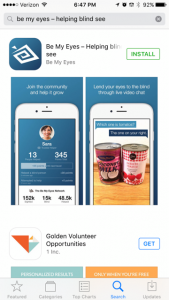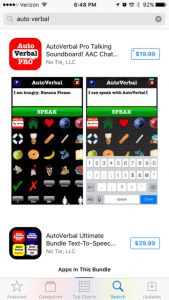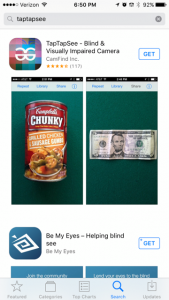Apps can help those with visual, hearing or speech impairments deal with routine aspects of life
By Deborah Jeanne Sergeant

Phone apps have made many areas of our lives easier. For people who live with visual, hearing and speech disabilities, some apps can offer assistance that’s much more convenient than help offered by a separate device.
Since many people already carry smartphones everywhere, the apps are always ready to help. Plus, smartphones — used by people of all abilities — lack the stigma that some people attach to devices such as soundboards used by some people with speech impairment.
People with visual impairment can “borrow” others’ vision with Be My Eyes (iOS, Android coming soon; free). The app links volunteers with users to offer them assistance by verbally describing whatever users show them on their smartphones’ cameras, from street signs to instruction booklets.
Many people who are visually impaired fold or carry their paper currency in ways that identify it; however, receiving change in paper currency relies upon others’ honesty and accuracy. But LookTel Money Reader (iOS; free) helps visually impaired people identify and count money instantly. The app can identify numerous nations’ currency, making traveling easier, too.
Need something read ASAP? KNFB Reader (iOS; $99.99) can read text aloud, from a single page to several pages.
TapTapSee (iOS; free) can verbally identify everyday objects in real time. It reads barcodes and also draws upon cloud-based image recognition technology.
People with limited vision can instantly enlarge their view of anything they see with AMagnifiy (Android; free). The app can blow up text or objects around the user, and capture enlarged images, all while maintaining the resolution needed to see the subject more clearly.

A similar app, Smart Magnifier (Android; free), works like a digital magnifying glass. Or, users can zoom in on just a portion of what they’re viewing on the screen.
As its name indicates, Color Identifier (iOS and Android; free) helps users accurately identify colors and speaks their names aloud for users.
Dragon Dictation (iOS; free) makes it easier for people who hear to communicate with someone who is hearing impaired. The app turns spoken words into written text. People who read lips understand about 30 percent of their conversations. This app provides word-for-word communication for when accuracy is vital.
Virtual Voice (Android; free) and AutoVerbal (iOS; $19.99) help people with speech impairment communicate by translating text into speech. Virtual Voice uses a robotic-sounding voice, but is easy to use. AutoVerbal allows users to select the voice’s gender, program custom phrases, and provides “speed dial” buttons for commonly used phrases.
Talkitt (iOS, Android; cost unknown) helps people with speech impairment by translating their speech into clearer speech. By learning the user’s speech patterns, the app can help them use their own voice for communicating.
RogerVoice Caption Calls (iOS, Android; free) provides real time phone conversation subtitles and, optionally, text to speech for the sake of the person on the other end. The app requires an Internet connection during use.

Learning sign can help improve communication among people with hearing and hearing impairment. Marlee Signs (iOS; free) and Spread the Sign (Android; free) offer comprehensive sign language dictionaries that can help teach anyone sign language.
